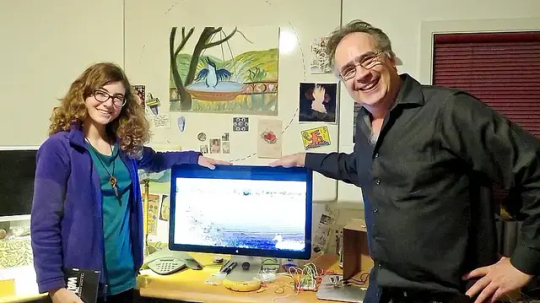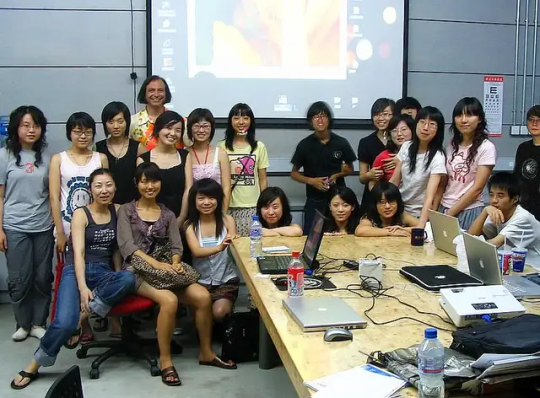#Multimediaelements
Explore tagged Tumblr posts
Text
Ignite Curiosity, Fuel Achievement: Transform Education with Dynamic Strategies and Multimedia-rich Lesson Plans

Generation Z, or individuals born from 1997 to 2012, has grown up in a digital age inundated with information. They are used to multi-tasking and consuming information in bite-sized chunks, leading to a reported attention span of only 1.3 seconds. This presents a challenge for educators who need to capture and maintain the attention of students in order to promote learning. In this article, we will explore how teachers can address this attention span issue and engage students effectively.

CAFA Class with Dan Zen at Presentation of Dan Zen Work. Photo by Dan Zen. Flickr.
Interactivity and Involvement
One of the main benefits of interactive activities in the classroom is increased engagement. When students are actively involved in the learning process, they are more likely to retain information and stay focused. Interactive activities such as group discussions, role-playing, and problem-solving allow students to engage with the material in a way that passive learning can't match. For example, during a group discussion, students can bounce ideas off of one another, building on what their peers have said and gaining a deeper understanding of the subject matter. Another benefit of interactive activities is that they allow students to take ownership of their learning. When students are given the opportunity to participate in the learning process, they feel more invested in their education. By empowering them to take an active role in their education, teachers can help students become more self-directed learners. This can result in increased motivation and a stronger sense of academic achievement. Interactive activities are also effective in promoting critical thinking and problem-solving skills. When presented with a real-world problem, students are forced to think creatively and come up with solutions. For instance, when working through a math-based problem-solving activity, students will need to use logic, reasoning, and mathematical knowledge to arrive at a solution. These skills are not only valuable in the classroom but also in everyday life. It's worth noting that the benefits of interactive activities extend beyond the classroom walls. Many of these activities can be adapted for online learning, making them effective tools for remote teaching. For example, online group discussions can be facilitated through video conferencing software, while interactive games and quizzes can be created using tools such as Kahoot or Quizlet Live. This allows teachers to engage with students in a meaningful way, even when they are not in the same physical space.
Multimedia Elements
As the next generation of students, Gen Z brings a unique set of characteristics and preferences to the classroom. Gen Z students have grown up with technology and crave interactive and engaging experiences. With teachers' tasked to keep their attention and interest in learning, integrating multimedia elements into lesson plans has become essential. Multimedia Elements Cater to Different Learning Styles Gen Z students have different learning styles, and it can be challenging for teachers to cater to each one. Incorporating multimedia elements into lesson plans can help by providing visual, auditory, or kinesthetic learning experiences. Images and videos can help visual learners, while narratives and audio can aid auditory learners. Kinesthetic learners, on the other hand, can benefit from animations and simulations as they require movement and interaction. By using multimedia elements, teachers can create a diverse and inclusive learning environment that caters to each student's strengths. Bite-Sized Learning is More Effective Multimedia elements are critical to creating bite-sized learning, which is essential to Gen Z students. Bite-sized learning provides students with information in easily digestible chunks, making it easier to retain information. This approach is similar to how social media delivers content, and Gen Z students are more likely to engage with this style of learning. With multimedia elements, teachers can create micro-learning activities such as quizzes, group discussions, and short videos, which are proven to be more effective than traditional lectures. Multimedia Elements Create a Conducive Learning Environment Gen Z students can easily lose interest in traditional classroom teaching methods. The use of multimedia elements not only makes learning more interactive but also creates a conducive learning environment that's similar to their everyday online experiences. These multimedia elements can take the form of gamification, interactive simulations or discussions, and infographics, among others. By gamifying learning, teachers can get students to engage more and enjoy the learning process. Students Can Use Multimedia Elements to Create Content In addition to consuming multimedia learning materials, Gen Z students enjoy creating content in different multimedia formats. By giving students the chance to create videos, animations, infographics, or podcasts, they can learn new skills whilst being more engaged in the lesson material. Multimodal teaching that encourages creativity and critical thinking can help develop a student's digital literacy, which is critical in the modern world.
Gamification and Competition
One of the primary benefits of gamification and competition in the classroom is that it improves engagement. By using these strategies, students become more energetic about the learning process, as they are more involved and eager to win the game. When competition is involved, students become more attentive, and focused, and are more likely to participate in the classroom. By infusing competition into classroom activities, teachers can motivate students to complete tasks that they may not have been otherwise interested in or willing to participate in. Another advantage of gamification and competition is that it helps students to learn better by applying critical thinking and creativity. By challenging them to provide innovative solutions or to solve complex puzzles through friendly competition, they get to develop creativity and problem-solving skills that are quite important in life. The use of gamification in the classroom also provides students with a sense of accomplishment, as they can measure their progress, and track their growth over time. Furthermore, gamification and competition allow for a unique way of teaching students teamwork and collaboration skills. By involving students in team games, students get to work and communicate together to achieve a shared objective, which can apply to various situations in later life. These skills are essential in a world that requires individuals to be effective communicators, collaborators, and team players. Additionally, gamification encourages the involvement of every student, including those who may have previously found it challenging to participate in a traditional classroom setting. Gamification strategies create an equal and inclusive environment that caters to the different learning styles of every student. It helps students who learn through interaction and visual cues to learn better and faster than students who prefer a conventional method.
Real-life scenarios
A format that has proven to be effective in promoting engagement and retention is real-life scenarios. Engage students by using real-life scenarios during lesson plans, integrating many new concepts, and providing students with authentic and relevant learning experiences that help them connect with the material. This approach requires teachers to be innovative and creative, providing students with personalized learning experiences that cater to their attention span. Ways in which a teacher can be more creative include structuring the lesson plan around role-playing and problem-solving, as well as incorporating media sources such as movies, documentaries, or current events to make learning more meaningful. Real-life scenarios also allow students to be active participants in the learning process rather than passive consumers of the material. Allowing them to use their creativity and problem-solving skills to develop solutions or come up with answers on their own can help them gain a deeper understanding of the subject matter. This approach also helps students learn in an environment that promotes collaboration, as they will have to work together to find ways to solve the problems posed. Finally, real-life scenarios provide teachers with the opportunity to assess the level of understanding among their students. By incorporating interactive activities that require creative thinking and problem-solving, teachers can quickly identify areas where students are struggling, and help them to improve their understanding of the material. This kind of assessment helps teachers ensure that all students have a truly in-depth understanding of the concepts discussed in class.
Flexibility
Incorporating flexibility in the classroom setting is more appropriate for today's youth, who prefer to manage their own choices. Teachers should introduce personalized learning plans and flexibility in student engagement, providing students with a choice in how they engage with class lessons. This approach allows students to take charge of their own learning, granting them sufficient freedom to learn at their own pace.
Conclusion
The attention span of Generation Z continues to decline and presents the teaching profession with significant curriculum challenges. Educators must implement innovative strategies to accommodate this unique style of learning. Incorporating multimedia elements, interactive activities, gamification, real-life scenarios, and flexibility are all strategies that can be used by educators to address the issue of attention span while engaging students actively. By taking time to measure what motivates Gen Z students, educators can promote effective teaching practices and create lessons that keep their students engaged and attentive. Sources: THX News & Insider Intelligence. Read the full article
#Attentionspan#Bite-sizedlearning#Engagingstudents#Flexibilityintheclassroom#Gamification#GenerationZ#Interactiveactivities#Multimediaelements#Real-lifescenarios#TeachingstrategiesforGenerationZ
0 notes
Text
Upptäck framtiden för onlinelärande med en revolutionerande e-Learning-plattform
Internet har revolutionerat hur vi lever våra liv, och utbildningsvärlden är inget undantag. Med framväxten av e-lärande har onlineutbildning blivit ett alltmer populärt alternativ för alla som vill kompetensutveckla sig i sin egen takt och enligt sitt eget schema. Nu, med intåget av en revolutionerande e-learning-plattform, har distansledarskapskurser och ledarskapsutbildning aldrig varit mer tillgängliga.
Elerno är en banbrytande e-lärande plattform som har utformats för att ge en omfattande och engagerande lärandeupplevelse för alla över hela världen. Oavsett om du vill skaffa dig nya färdigheter eller förbättra dina befintliga kunskaper, har Elerno en rad kurser och utbildningsprogram som hjälper dig att nå dina mål.

En av de mest populära kurserna som finns på Elerno är distansledarskapskursen, som har utformats speciellt för att hjälpa individer att förbättra sina ledarskapsförmåga från bekvämligheten av sitt eget hem. Kursen täcker ett brett spektrum av ämnen, inklusive kommunikation, teambuilding och konflikthantering, som alla är viktiga för effektivt ledarskap.
Förutom ledarskapsutbildning erbjuder Elerno olika kurser utformade för att hjälpa individer att skaffa nya färdigheter och kunskaper inom flera områden. Från kontroll före idrifttagning till konflikthantering, det finns en kurs som passar allas behov.
En av de viktigaste fördelarna med att använda en e-lärande plattform som Elerno är flexibiliteten den ger. Deltagare kan lära sig i sin egen takt, enligt sitt eget schema och från bekvämligheten av sina egna hem. Detta är särskilt fördelaktigt för individer som har fullspäckade scheman eller bor i avlägsna områden där tillgången till traditionell utbildning kan vara begränsad.
En annan fördel med att använda Elerno är kvaliteten på den lärandeupplevelse den ger. Plattformen är utformad för att vara engagerande och interaktiv, med olika multimediaelement, inklusive videor, animationer och interaktiva praktiska övningar, för att hålla eleverna motiverade och engagerade under hela kursen.
Framtiden för onlinelärande har anlänt med Elerno. Oavsett om du vill förbättra dina ledarskapsförmåga med en distansledarskapskurs eller skaffa dig ny kunskap inom ett specifikt område, har Elerno allt du behöver för att lyckas. Med sin engagerande och flexibla e-lärande plattform är Elerno det perfekta valet för alla som vill förbättra sin utbildning och uppnå sina mål.
Elerno är mer än bara en e-lärande plattform - det är en gemenskap av elever och utbildare som brinner för att dela kunskap och skapa ett mer informerat och utbildat samhälle. Genom Elernos plattform kan deltagare få kontakt med andra deltagare och instruktörer över hela världen, dela idéer, samarbeta i projekt och bygga professionella nätverk.
Dessutom är Elernos kurser utformade för att vara tillgängliga för alla, oavsett bakgrund eller erfarenhetsnivå. Oavsett om du är ett erfaret proffs eller precis har börjat i din karriär finns det en kurs som kan hjälpa dig att nå dina mål.
Elernos plattform erbjuder också en rad fördelar för organisationer och företag som vill erbjuda professionella utvecklingsmöjligheter för sina anställda. Plattformen kan anpassas för att möta din organisations specifika behov, med kurser och utbildningsprogram utformade för att hjälpa dina medarbetare att skaffa sig de färdigheter och kunskaper de behöver för att lyckas i sina roller.
Klicka här för mer information:-
ledarskapsutbildning distans
bas u utbildning
0 notes
Photo

MIKE BOURSCHEID E VANESSA BROWN The hand that topples the tower
Due diversi approcci artistici si uniscono nell’emblematico ex sito industriale di Dudelange per immergere il visitatore in un’esperienza multimediaele
0 notes